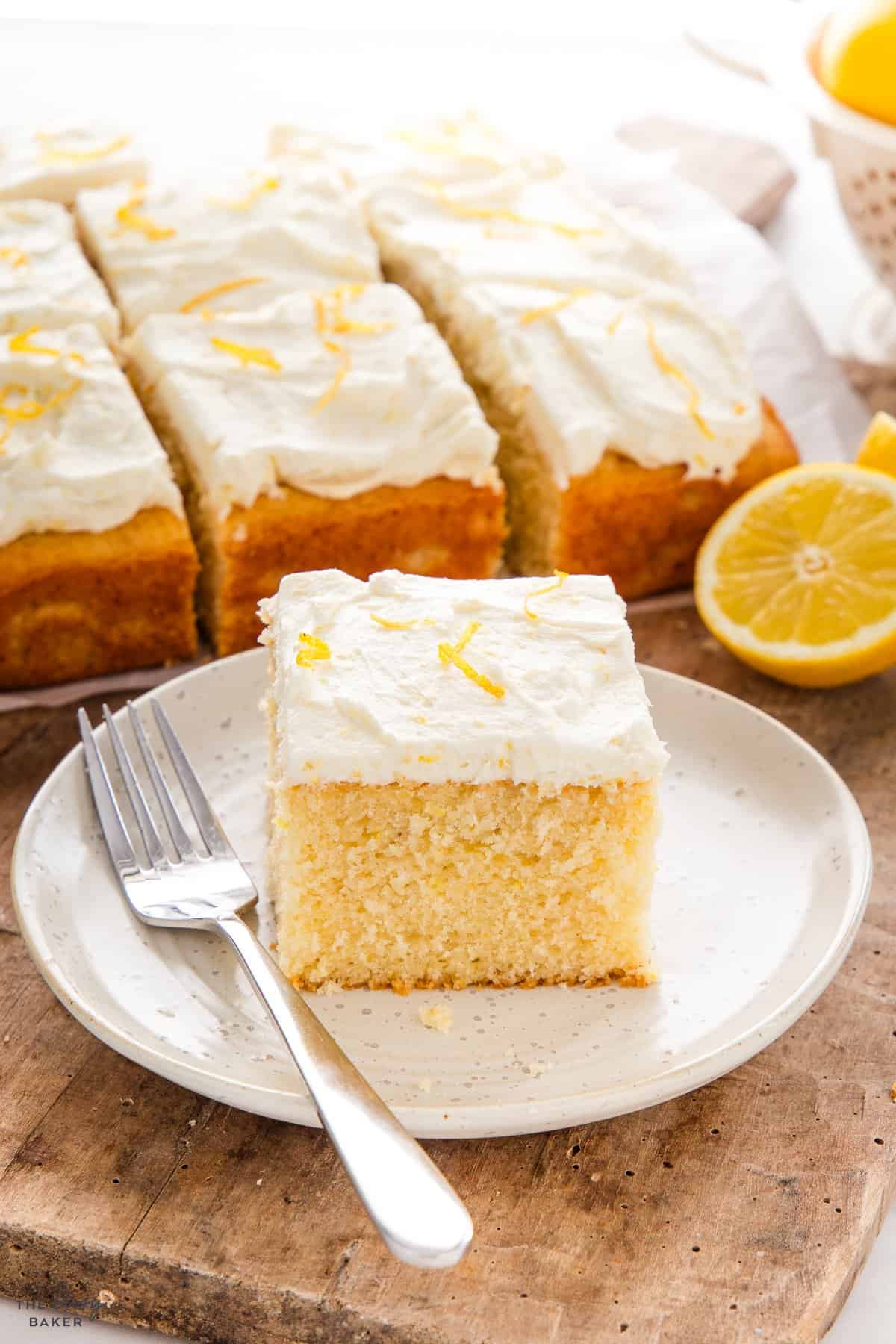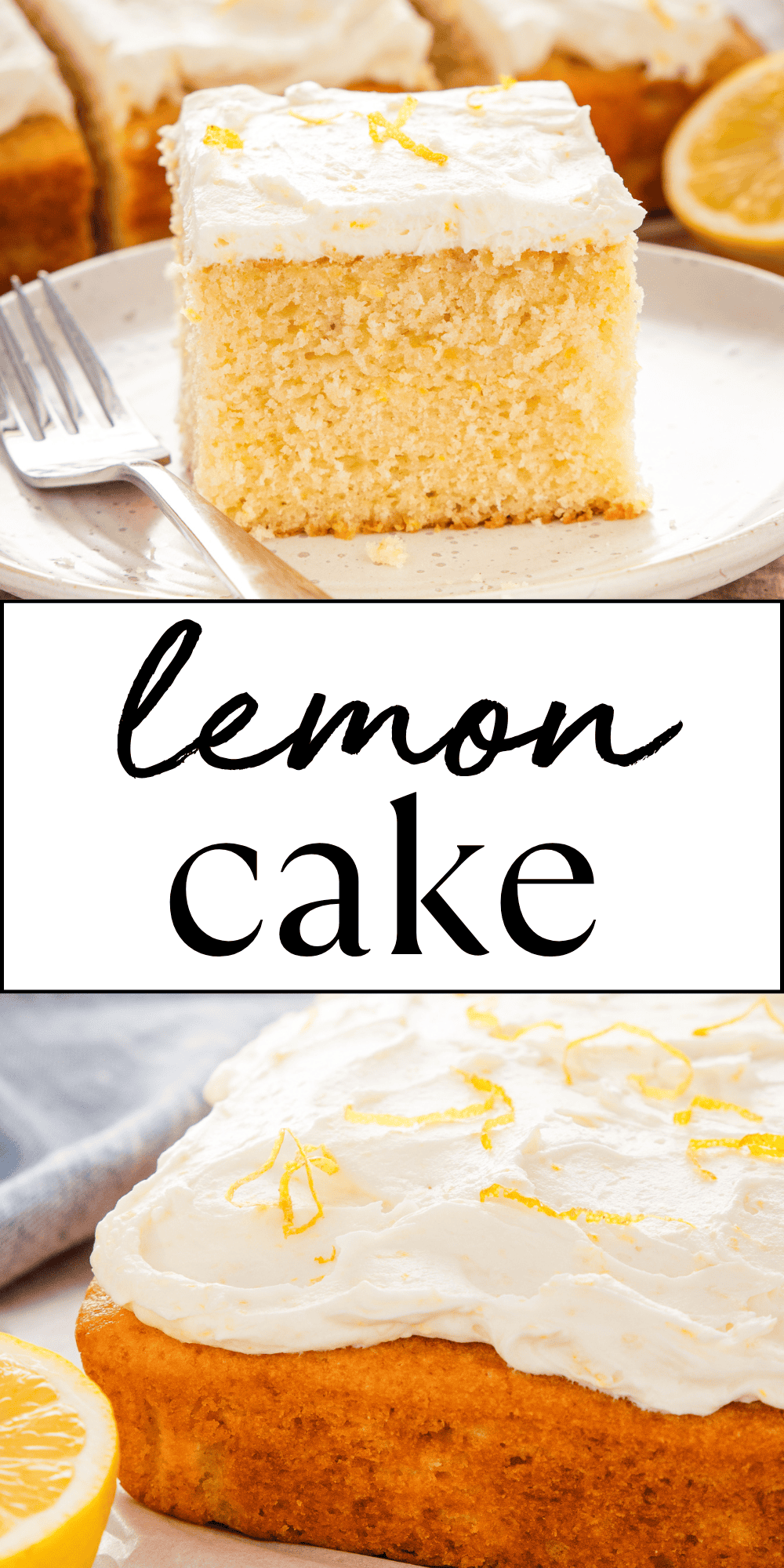This easy Lemon Cake recipe with lemon buttercream frosting is a simple dessert made with real lemons! It’s an easy cake recipe for beginners!
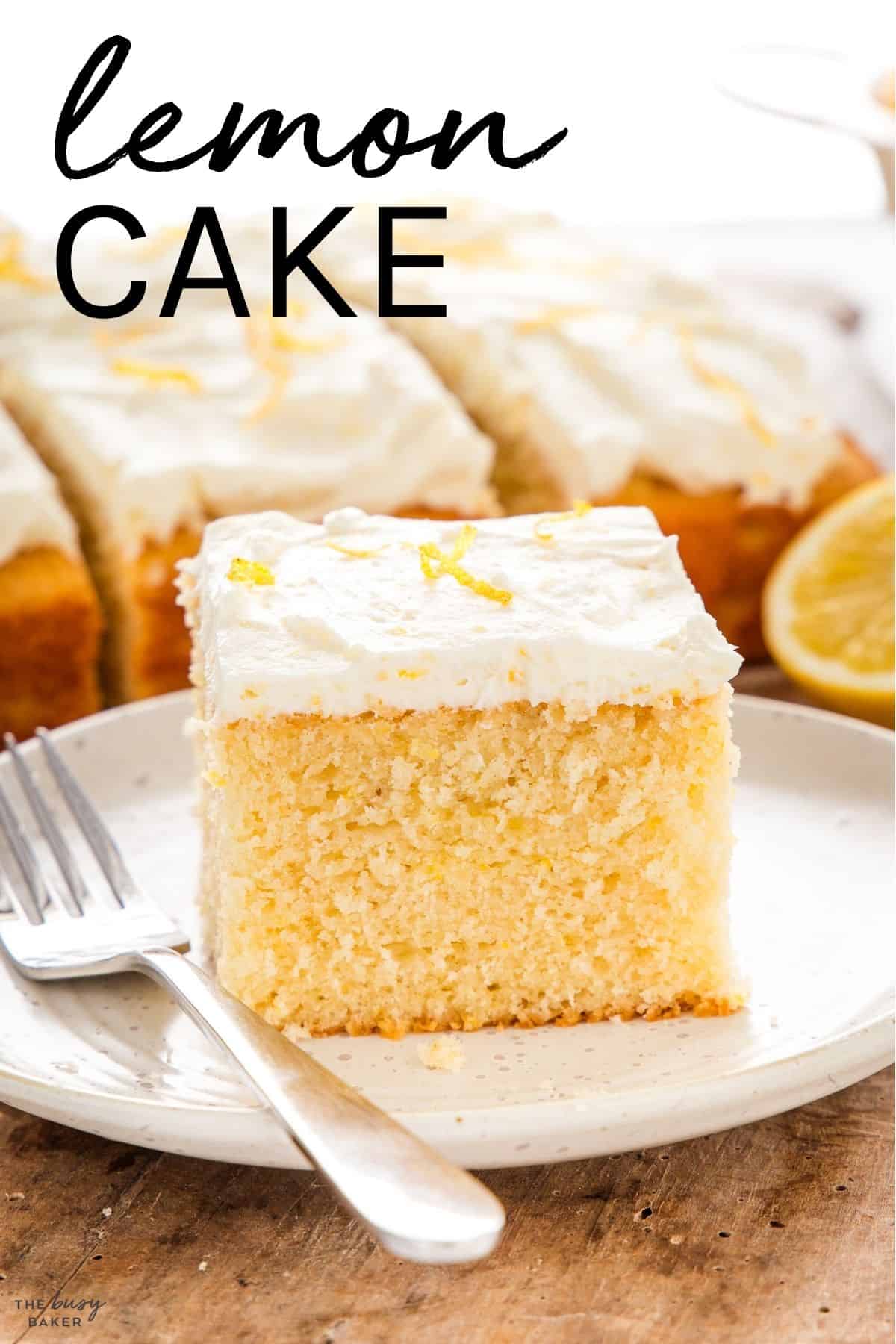
Estimated reading time: 7 minutes

Lemon cake is a soft, moist and tender dessert topped with a fresh buttercream frosting. It’s simple and zesty with the perfect balance between sweetness and tartness.

- It’s ZESTY & FRESH thanks to the lemon zest and juice we’re using.
- It calls for SIMPLE INGREDIENTS that you probably already have in your kitchen and pantry.
- It’s SOFT & MOIST because of the butter, oil, and the buttermilk.
- It’s great in SMALL BATCHES, making an 8×8 inch square pan but it also workes well, doubled, in a 9×13 inches pan for a crowd.
- It’s VERSATILE – you can serve it plain, with berries or even double it and make it a layer cake with some Lemon Curd in the middle.
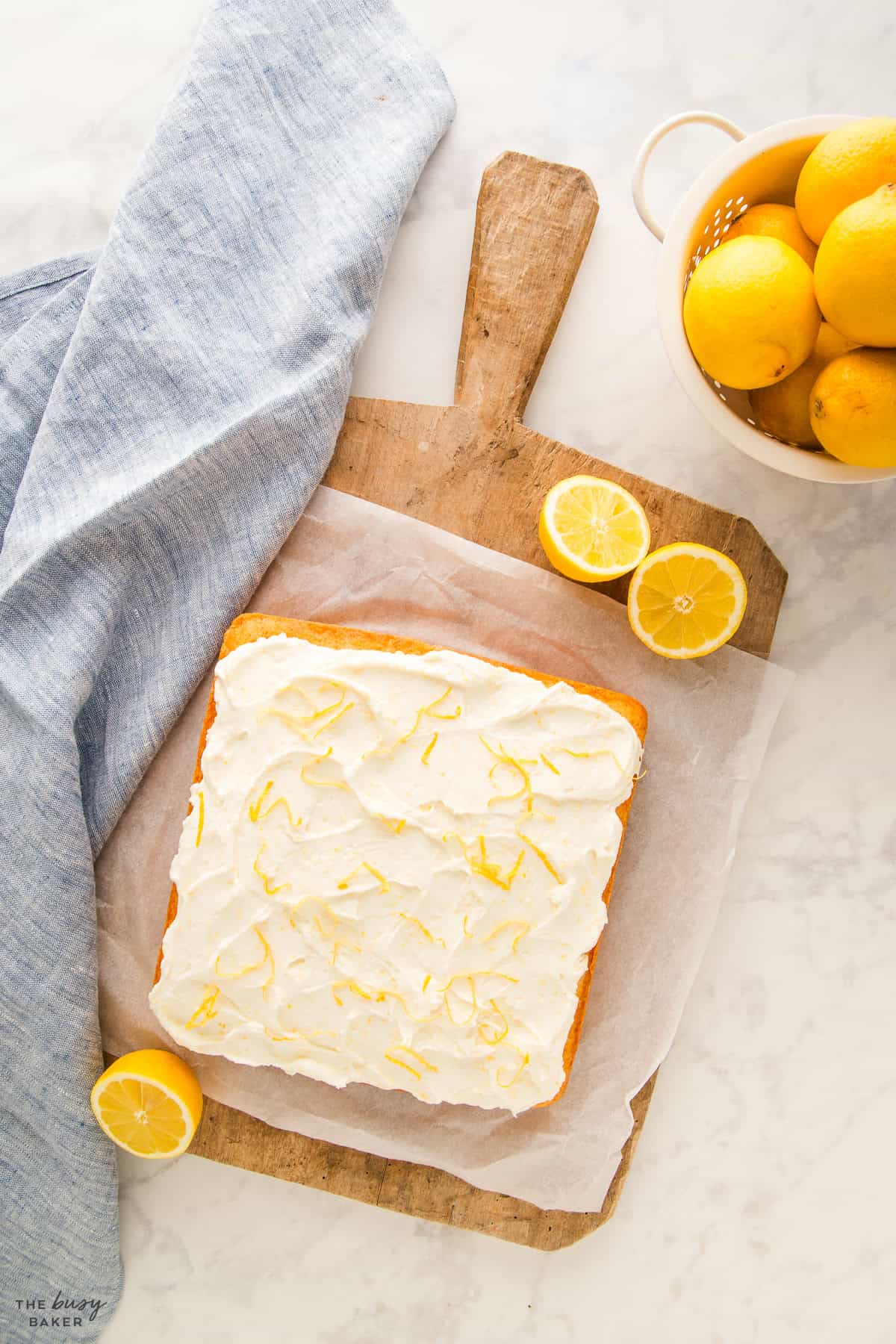
Both the zest and juice play an important role in the flavour and tanginess of the cake. Using fresh lemons ensures you get the best lemon flavour without the artificial taste.
For a light crumb and a moist cake, stop mixing the batter as soon as it is smooth and everything is incorporated.
It’s easy to forget to zest the lemons before juicing them (you will need both for the frosting), so our advice is to zest all your lemons first, making sure to save some zest for decoration.
This will ensure that the frosting won’t melt and you’ll be able to spread it evenly, creating patterns to your preference. We love a rustic look with some swirls and some lemon zest for garnish.
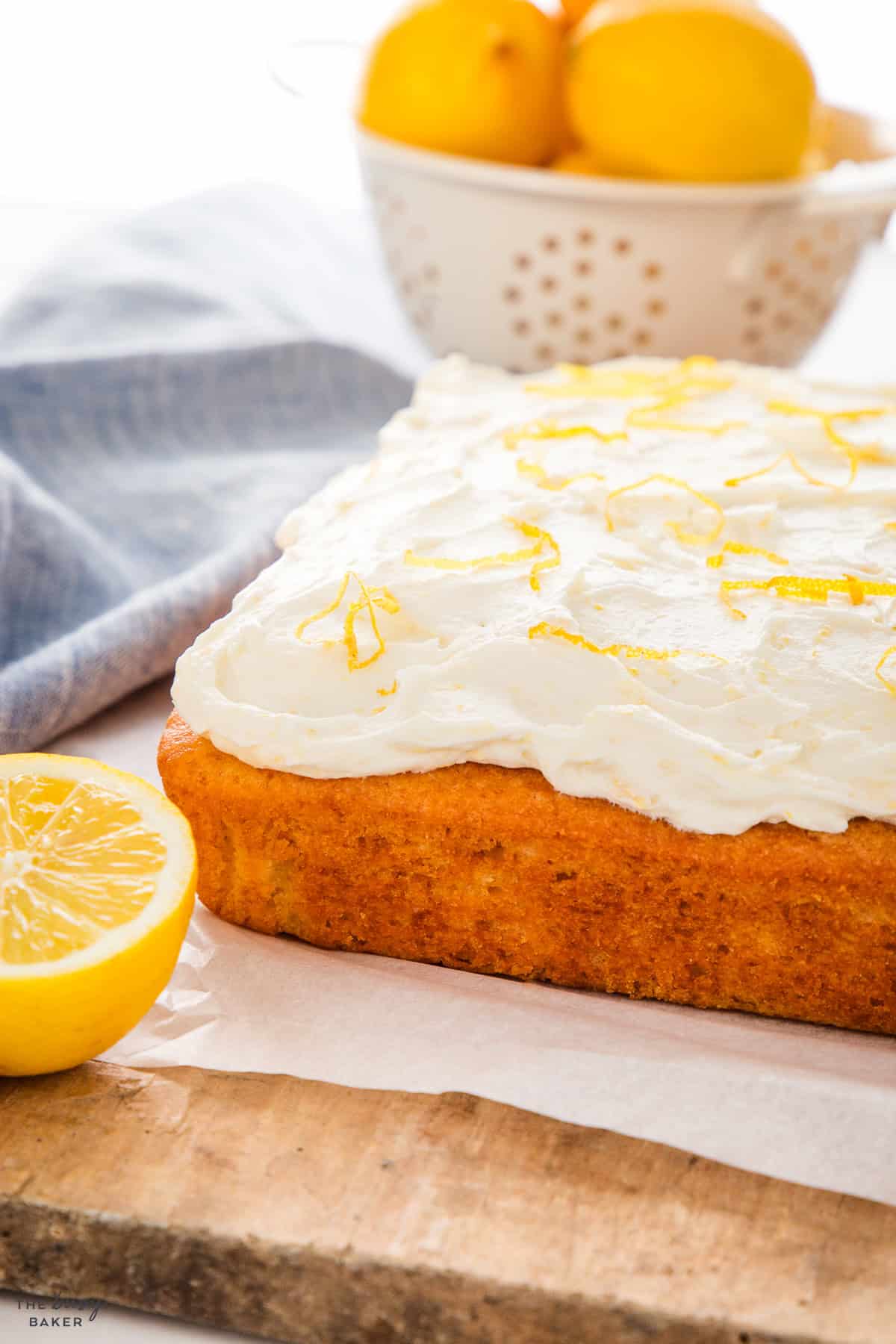
Make sure you don’t overmix your batter and you use fresh baking powder.
Always test your cake in the middle with a toothpick before you remove it from the oven. If the toothpick comes out clean, your cake is done.
Make sure you’re using fresh baking powder and you only mix the batter until the dry ingredients are incorporated.
Make sure you measure your flour correctly, as too much flour can create a dry cake. Over baking might also cause a crumbly cake, so make sure you toothpick test your cake around the time it’s supposed to be done (or earlier if your oven runs hot).
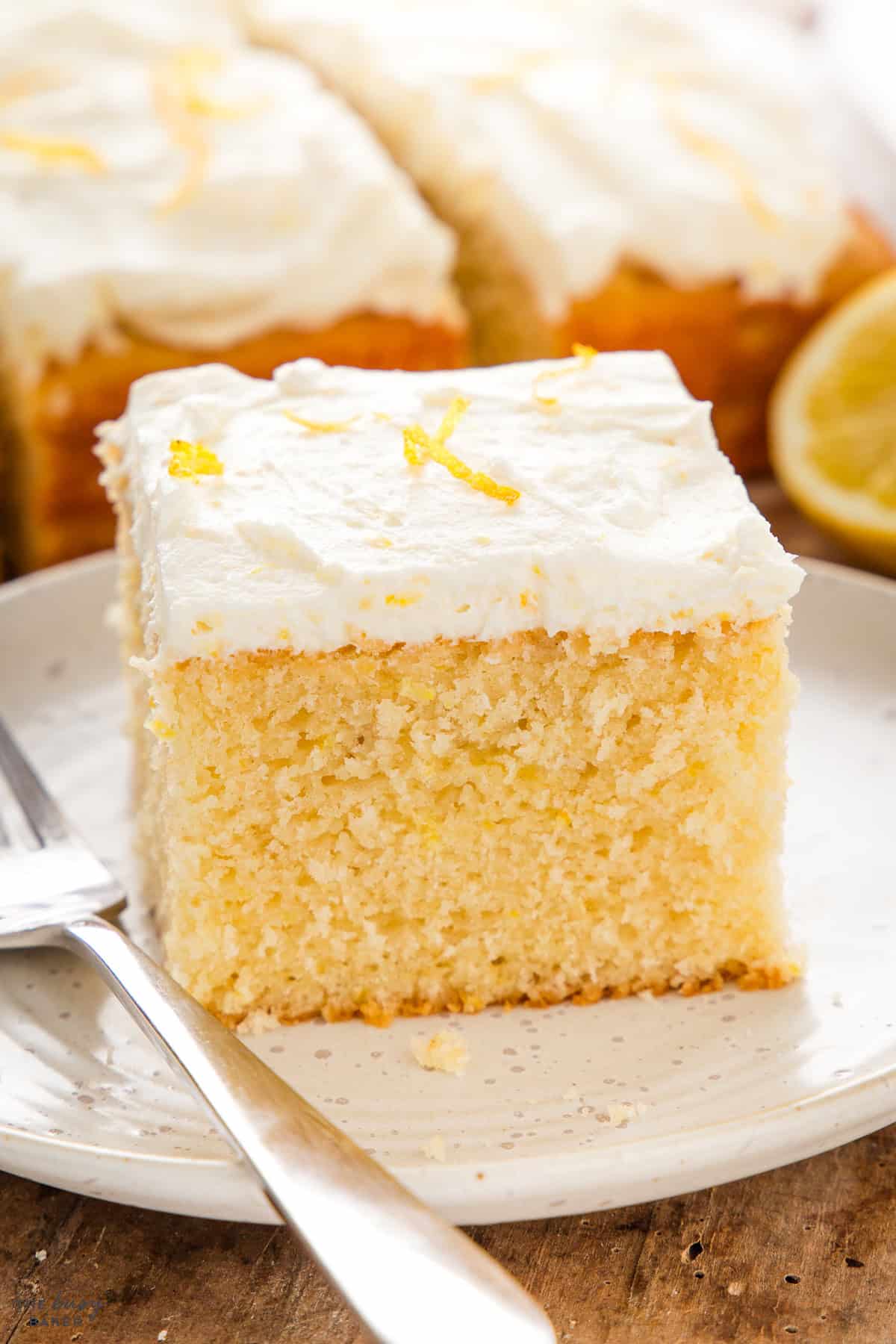
- mixing bowls
- measuring cups and spoons
- liquid measuring cups
- Silicone Spatula
- Whisk
- Hand Mixer
- Stand Mixer
- Offset Spatula
- square cake pan
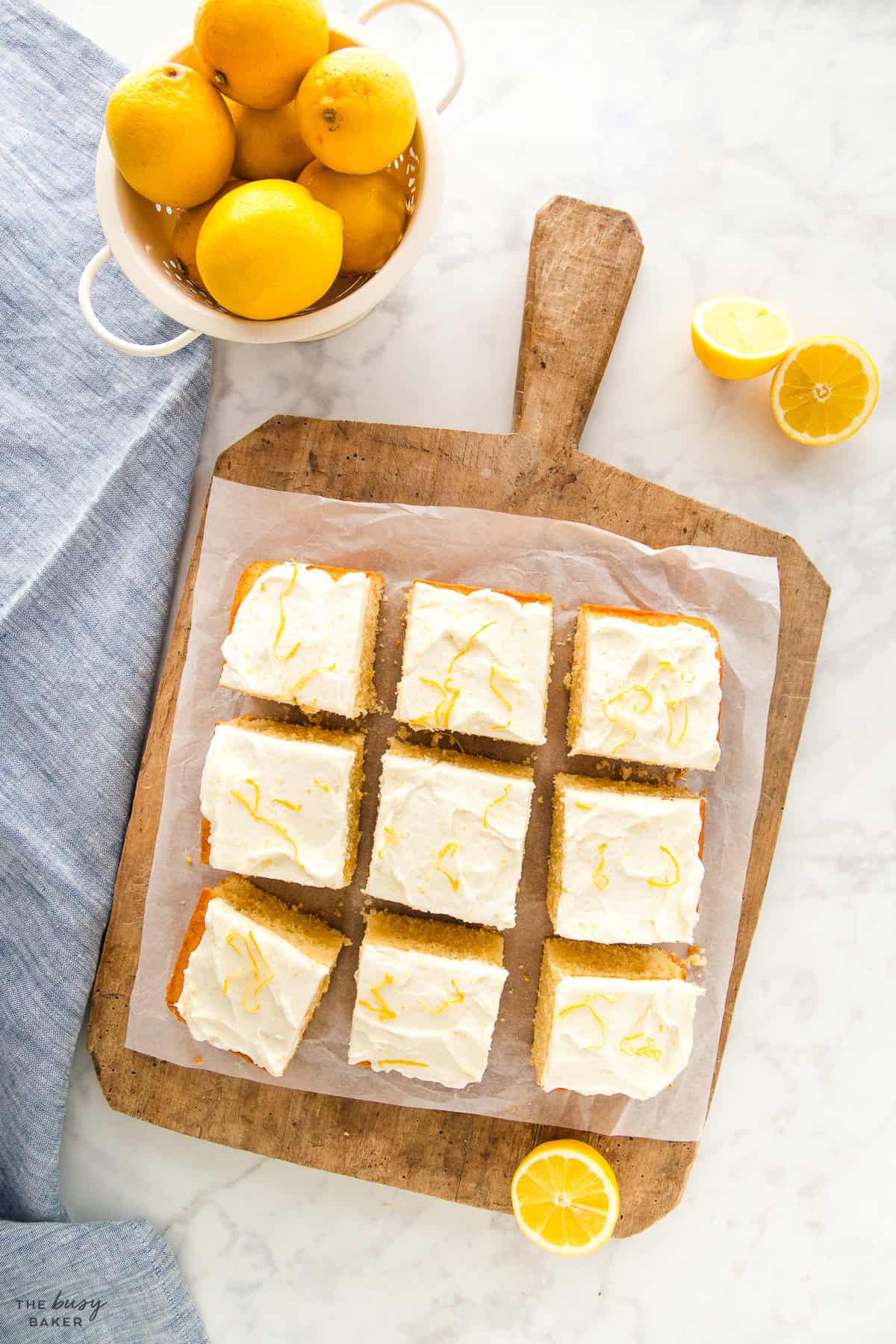
For the Cake
- 1 cup sugar
- 3 lemons zest
- 1/2 cup butter
- 2 eggs
- 1 teaspoon vanilla
- 1/4 cup oil
- 2/3 cup buttermilk
- 1 3/4 cups all purpose flour
- 1 1/2 teaspoon baking powder
- 1/4 teaspoons salt
For the Frosting
- 1/2 cup unsalted butter at room temperature
- 1 1/2 cups powdered sugar
- 1 teaspoon vanilla extract
- 1/4 teaspoon salt
- 1 tablespoon heavy cream
- 1 lemon zest and juice
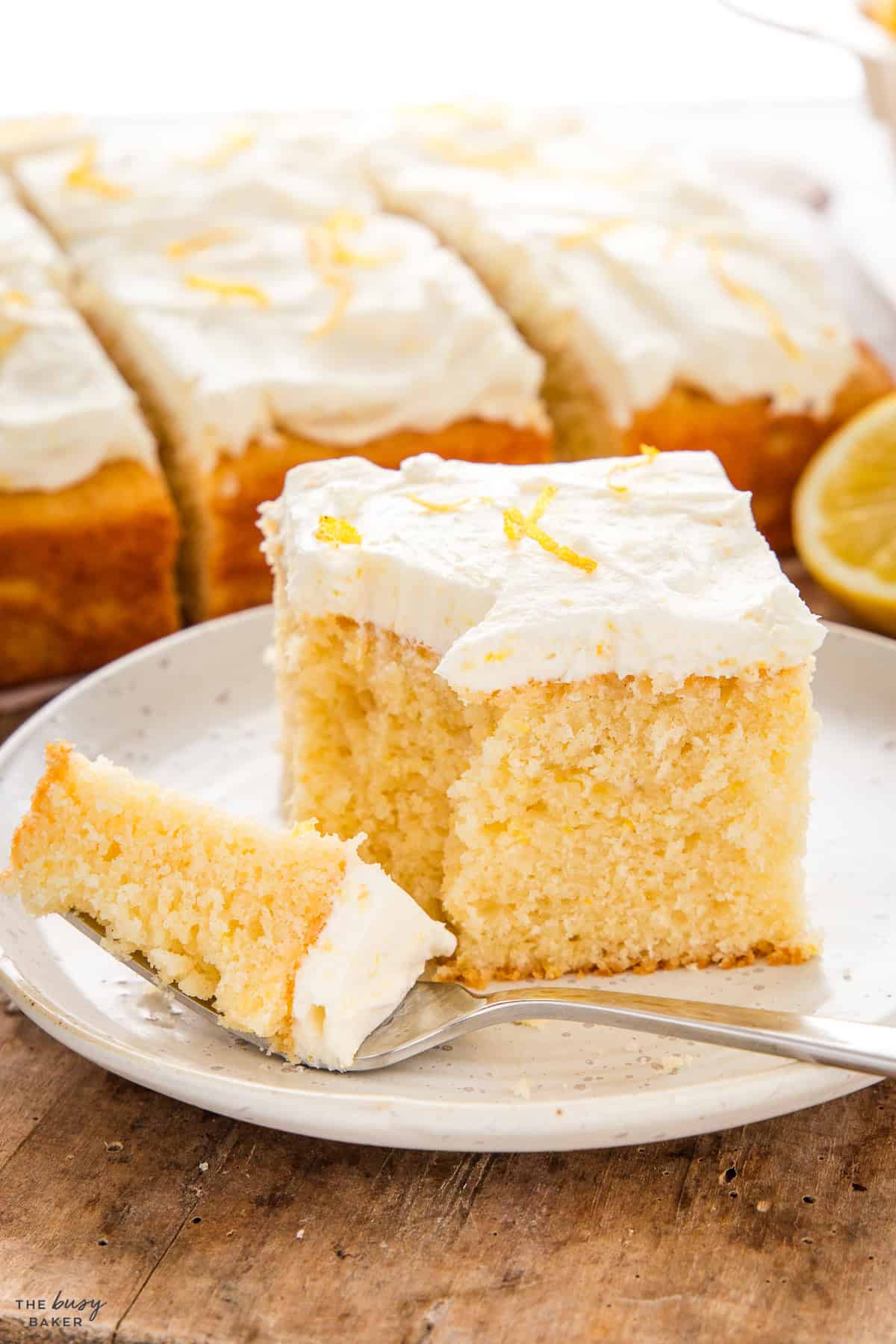
Time needed: 1 hour and 40 minutes
- Prepare to bake.
Preheat your oven to 325 degrees Fahrenheit (165 degrees Celsius) and prepare a square cake pan by greasing it with butter or baking spray and lining it with parchment paper. Set it aside.
Add the flour, sugar, baking powder, and salt to a large mixing bowl and whisk together until combined. - Make the batter.
In the bowl of your stand mixer fitted with the whisk attachment, add the sugar and the lemon zest.
Mix well until the lemon zest releases its essential oils and the sugar has the consistency of wet sand.
Add the butter and whisk until light and fluffy.
Add the eggs, oil, vanilla, and buttermilk and mix until homogenous.
Add the dry ingredients and mix together on low speed just until the mixture is smooth. Make sure you don’t over mix your batter. - Bake!
Pour the batter into the prepared baking pan and bake for about 25-30 minutes at 325 degrees Fahrenheit (165 degrees Celsius). To see if the cake is done, insert a toothpick into the centre. If it comes out clean, the cake is done.
Place the cake pan on a wire rack to cool completely. - Make the frosting.
Add the butter to a mixing bowl and mix on high speed with a hand mixer until pale in colour (2-3 minutes).
Add the powdered sugar, half cup at a time, until well combined. Be sure to scrape down the sides of the bowl.
Add the zest of a lemon and about a tablespoon of the juice. Feel free to add more juice if you want a tangier taste.
Add the vanilla and salt and mix well to combine.
Add the heavy cream a little bit at the time, just until the frosting reaches a fluffy, light consistency. - Frost, garnish, and serve!
Be sure to frost the cake after the cake has cooled completely. Adding frosting to a hot cake will cause the frosting to melt.
Add the frosting on top of the cake and use an offset spatula to push the frosting out to the edges of the cake, smoothing out the top.
Decorate with lemon peel or lemon slices.
Slice and serve immediately or store at room temperature until ready to serve.
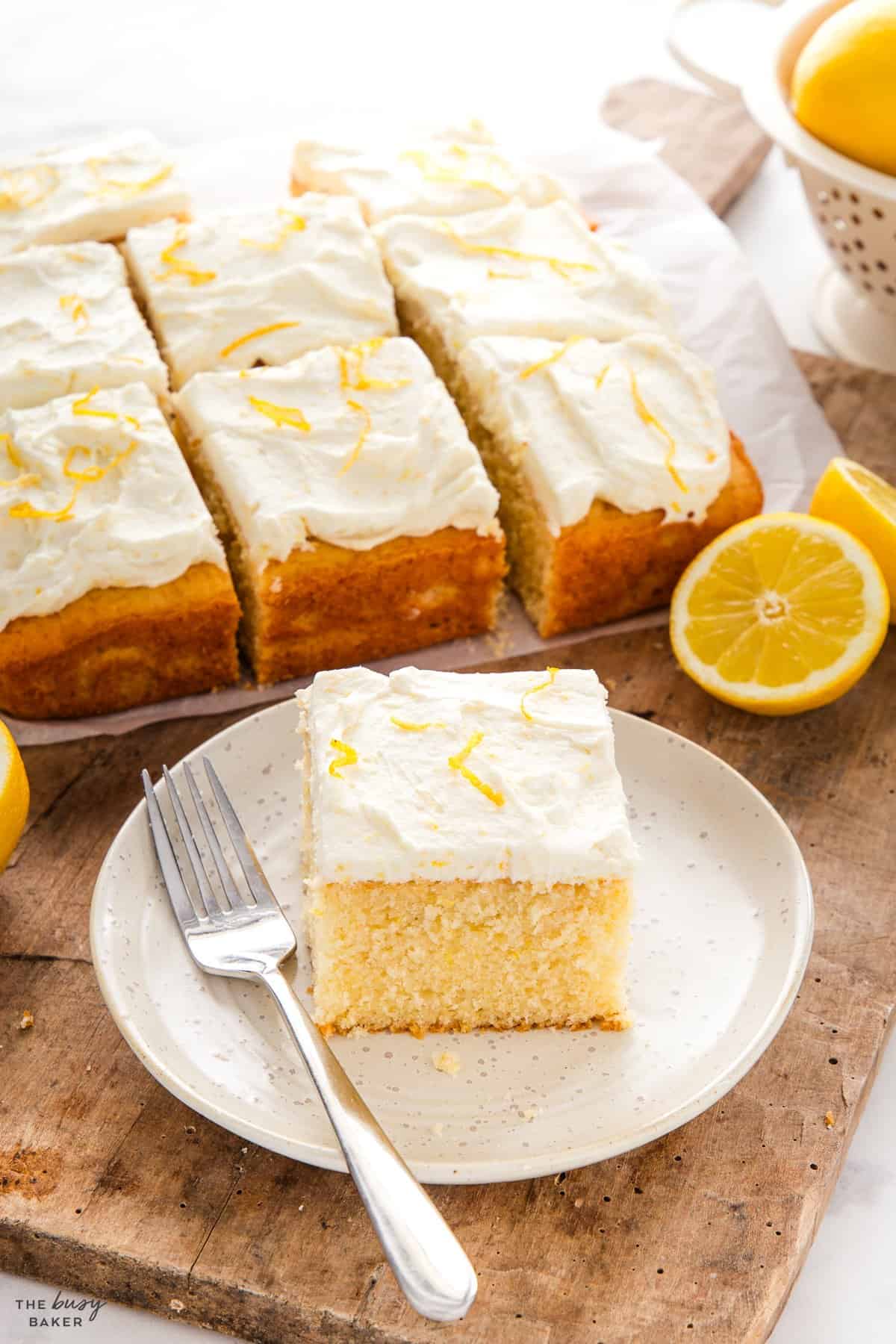
Can I use this recipe as a layer cake or a sheet cake?
For sure! Double the recipe and bake in 2 round cake pans or in a 9×13 inch pan.
Can I add lemon curd to this cake?
Yes! Sure! We love turning this into a layer cake and adding Lemon Curd between the layers. It makes for such an easy and fresh cake!
Can I reduce the sugar?
You can reduce about 1/4 cups of sugar from the batter, but reducing more might change its texture.
Can I frost this cake with cream cheese frosting?
Yes, you can. We prefer lemon buttercream frosting, but it will for sure work with cream cheese frosting.

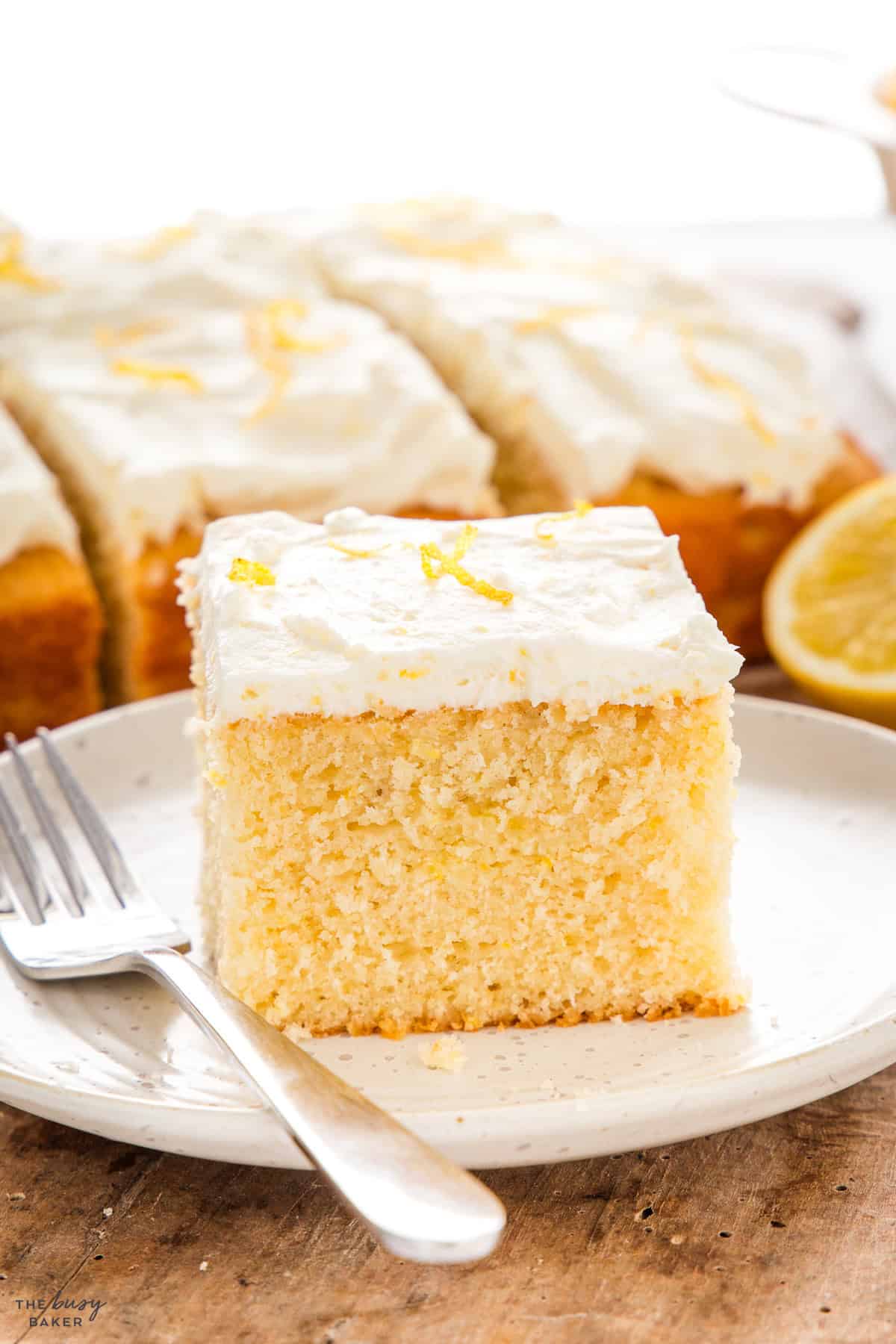
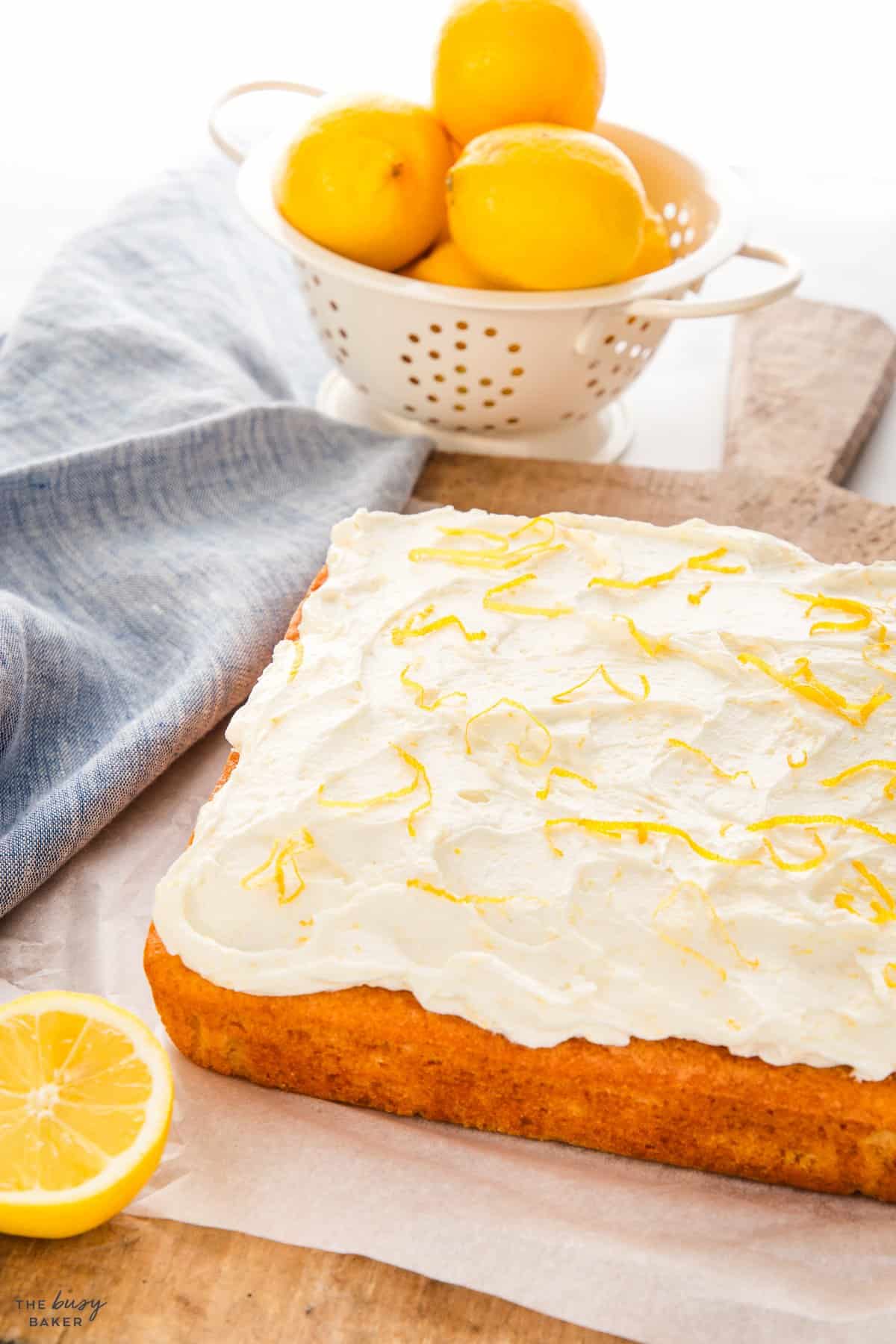
If you made this, share a photo!
Are you trying this recipe? Use the comment form below to share your take; now with support for image uploads and comment voting!
Lemon Cake
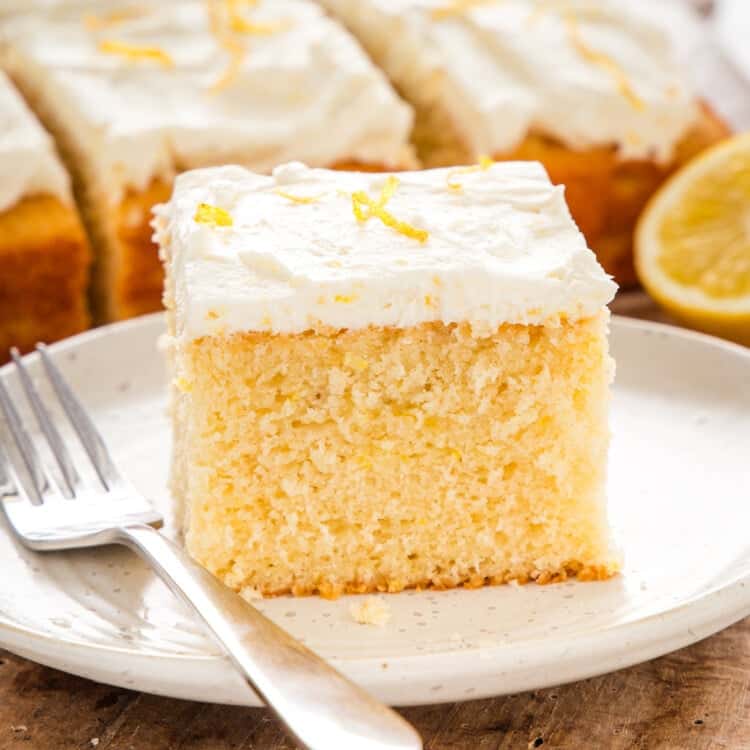
Recipe: Equipment
Recipe: Ingredients
For the Cake
- 1 cup sugar
- 3 lemons zest
- 1/2 cup butter
- 2 eggs
- 1 teaspoon vanilla
- 1/4 cup oil
- 2/3 cup buttermilk
- 1 3/4 cups all purpose flour
- 1 1/2 teaspoon baking powder
- 1/4 teaspoons salt
For the Frosting
- 1/2 cup unsalted butter at room temperature
- 1 1/2 cups powdered sugar
- 1 teaspoon vanilla extract
- 1/4 teaspoon salt
- 1 tablespoon heavy cream
- 1 lemon zest and juice
Recipe: Instructions
For the Cake
- Preheat your oven to 325℉ (165℃) and prepare a square cake pan by greasing it with butter or baking spray and lining it with parchment paper. Set it aside.
- Add the flour, sugar, baking powder, and salt to a large mixing bowl and whisk together until combined.
- In the bowl of your stand mixer fitted with the whisk attachment, add the sugar and the lemon zest.
- Mix well until the lemon zest releases its essential oils and the sugar has the consistency of wet sand.
- Add the butter and whisk until light and fluffy.
- Add the eggs, oil, vanilla, and buttermilk and mix until homogenous.
- Add the dry ingredients and mix together on low speed just until the mixture is smooth. Make sure you don't over mix your batter.
- Pour the batter into the prepared baking pan and bake for about 25-30 minutes at 325℉ (165℃). To see if the cake is done, insert a toothpick into the centre. If it comes out clean, the cake is done.
- Place the cake pan on a wire rack to cool completely.
For the Frosting
- Add the butter to a mixing bowl and mix on high speed with a hand mixer until pale in colour (2-3 minutes).
- Add the powdered sugar, half a cup at a time, until well combined. Be sure to scrape down the sides of the bowl.
- Add the zest of a lemon and about a tablespoon of the juice. Feel free to add more juice if you want a tangier taste.
- Add the vanilla and salt and mix well to combine.
- Add the heavy cream a little bit at the time, just until the frosting reaches a fluffy, light consistency.
- Be sure to frost the cake after the cake has cooled completely. Adding frosting to a hot cake will cause the frosting to melt.
- Add the frosting on top of the cake and use an offset spatula to push the frosting out to the edges of the cake, smoothing out the top.
- Slice and serve immediately or store at room temperature until ready to serve.
Recipe: Notes
Storage Instructions
Store this cake in an airtight container at room temperature for up to 3 days.Freezer Instructions
We recommend freezing this cake unfrosted in an airtight container or tightly wrapped in plastic wrap. Defrost at room temperature and then frost before serving. It’s possible to freeze the cake once it’s been frosted, although the frosting might change slightly in texture as it freezes and thaws.Recipe: Nutrition
Notice: Nutrition is auto-calculated, using Spoonacular, for your convenience. Where relevant, we recommend using your own nutrition calculations.
